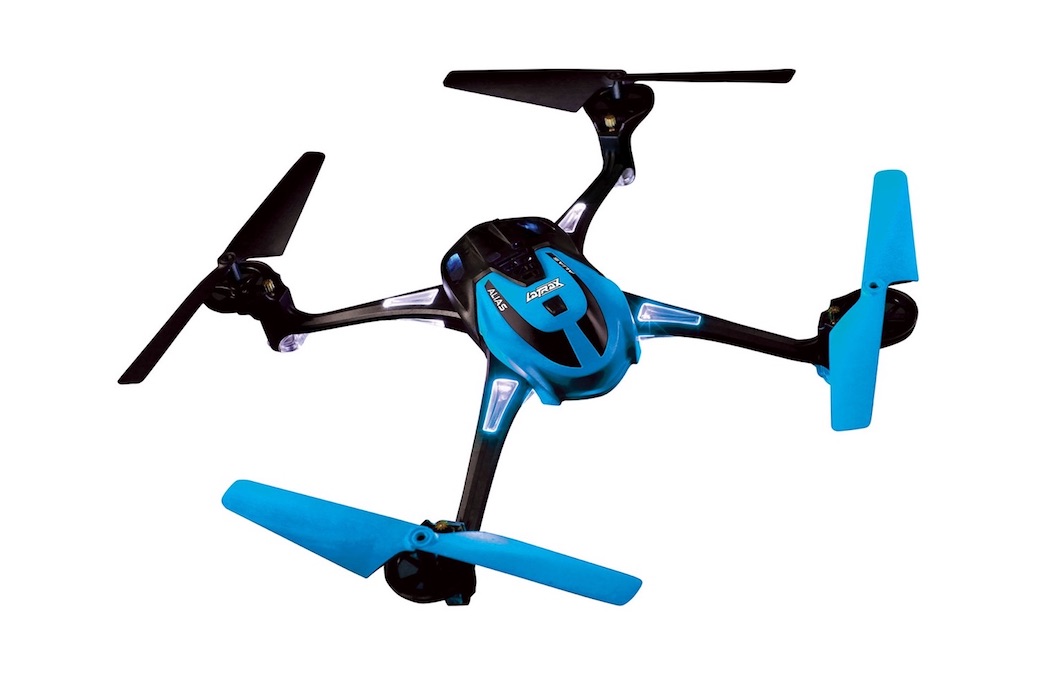 Today we take to the skies yet again with the supremely acrobatic LaTrax Alias Quadcopter Drone, which is one of the quickest (and also most erratic) drones I’ve ever attempted to fly. I say attempted because there was truly more crashing than flying, but still, it was certainly lots of fun to try! Keep on reading if you’d like to hear the results and learn all of the ins and outs of this cool little quad!
Today we take to the skies yet again with the supremely acrobatic LaTrax Alias Quadcopter Drone, which is one of the quickest (and also most erratic) drones I’ve ever attempted to fly. I say attempted because there was truly more crashing than flying, but still, it was certainly lots of fun to try! Keep on reading if you’d like to hear the results and learn all of the ins and outs of this cool little quad!
ALIAS INTRODUCTION
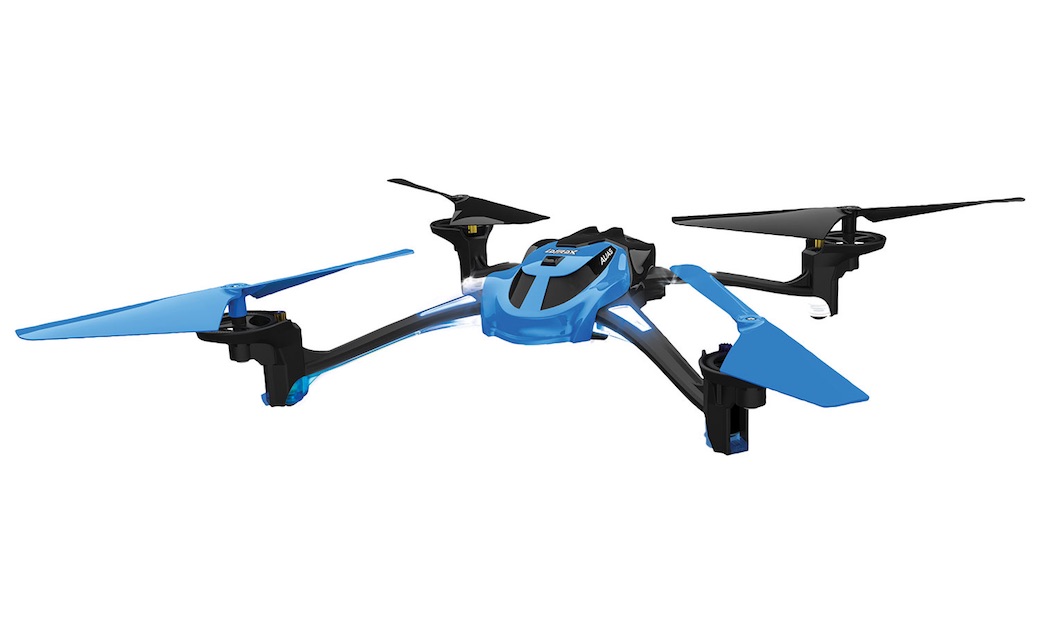 The LaTrax Alias Quadcopter is a high speed quadcopter drone that weighs just 100 grams and features 3 distinct flying modes (Easy Mode, Fast Mode, and Expert Mode). It also has the ability to perform amazing aerial acrobatic stunts such as flips, rolls, and twists. Additionally, this super lightweight drone has bright LED lights underneath for nighttime flying, it comes with a 1 cell 650 mAh LiPo battery (providing approximately 12 minutes of total flying time), and it features the LaTrax Auto-Leveling 6-Axis Flight System (which makes for very stable flying when in Easy Mode—the Alias’ default setting). As for speed, the Alias is supremely fast! It can reach speeds of up to 29 Km/s an hour (that’s 18 miles per hour) without any upgrades being done. If you choose to upgrade your Alias, it will then be capable of traveling at a top speed of 37 Km/h, which equates to 23 mph. Of course, even without upgrades, the Alias feels extremely fast when you’re flying in either Fast Mode or Expert Mode, and it must at least be in Fast Mode if you wish to perform any tricks. The Alias can be a bit tricky to fly, but it sure feels good when you successfully complete one of those tricks!
The LaTrax Alias Quadcopter is a high speed quadcopter drone that weighs just 100 grams and features 3 distinct flying modes (Easy Mode, Fast Mode, and Expert Mode). It also has the ability to perform amazing aerial acrobatic stunts such as flips, rolls, and twists. Additionally, this super lightweight drone has bright LED lights underneath for nighttime flying, it comes with a 1 cell 650 mAh LiPo battery (providing approximately 12 minutes of total flying time), and it features the LaTrax Auto-Leveling 6-Axis Flight System (which makes for very stable flying when in Easy Mode—the Alias’ default setting). As for speed, the Alias is supremely fast! It can reach speeds of up to 29 Km/s an hour (that’s 18 miles per hour) without any upgrades being done. If you choose to upgrade your Alias, it will then be capable of traveling at a top speed of 37 Km/h, which equates to 23 mph. Of course, even without upgrades, the Alias feels extremely fast when you’re flying in either Fast Mode or Expert Mode, and it must at least be in Fast Mode if you wish to perform any tricks. The Alias can be a bit tricky to fly, but it sure feels good when you successfully complete one of those tricks!
FLYING THE ALIAS DRONE
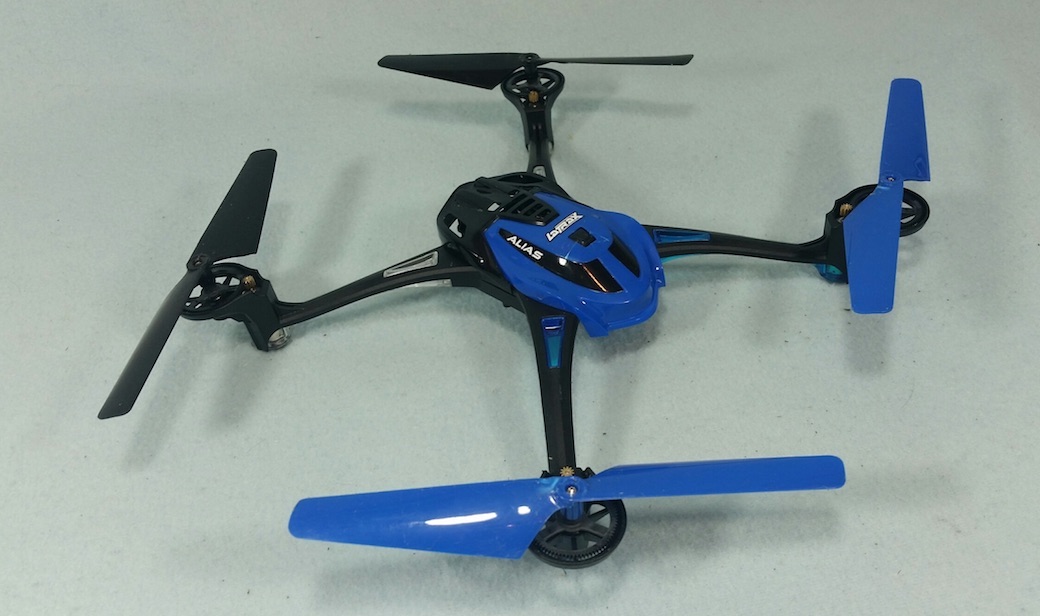 When I tested the Alias, the first thing I noticed was how difficult to control it was. Of course, on the day I was testing it, I was flying near water and it was also quite breezy outside. And obviously, either of these conditions can easily make for trouble. For one thing, I didn’t want to lose the drone in the water, so whenever it zoomed off in that general direction I pretty much had to abort the flight and go down while there was still some beach left to land on. Secondly, due to its super light weight, the Alias is very easily bothered by wind, and I do believe that I was blown about quite a bit during testing, which made most of my flights seem very erratic. I suspect that in dead calm weather (which we just haven’t been getting lately), the Alias might be significantly easier to fly. Of course, there’s always the “Easy Mode” option, but when your testing options are limited (mostly due to the nonstop rain in my area over the last few weeks) you really need to make the most of the opportunities that do arise, and for me this meant skipping the easy flight option and going right for the more advanced modes.
When I tested the Alias, the first thing I noticed was how difficult to control it was. Of course, on the day I was testing it, I was flying near water and it was also quite breezy outside. And obviously, either of these conditions can easily make for trouble. For one thing, I didn’t want to lose the drone in the water, so whenever it zoomed off in that general direction I pretty much had to abort the flight and go down while there was still some beach left to land on. Secondly, due to its super light weight, the Alias is very easily bothered by wind, and I do believe that I was blown about quite a bit during testing, which made most of my flights seem very erratic. I suspect that in dead calm weather (which we just haven’t been getting lately), the Alias might be significantly easier to fly. Of course, there’s always the “Easy Mode” option, but when your testing options are limited (mostly due to the nonstop rain in my area over the last few weeks) you really need to make the most of the opportunities that do arise, and for me this meant skipping the easy flight option and going right for the more advanced modes.
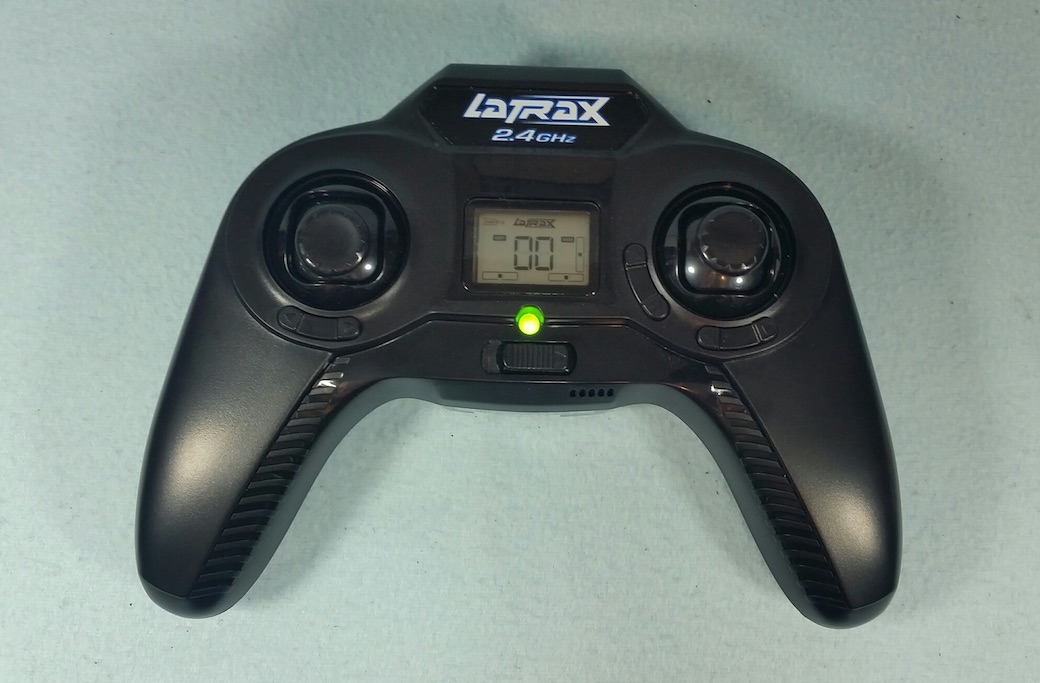 The Alias uses a 2.4GHz transmitter with a helpful display screen that provides all kinds of useful information to the user. For example, it tells you the remaining battery power—both for the drone itself and for the controller, as well as which mode you are currently flying in. It also provides a number of other, more technical, status details. The Alias’ controller runs on 4 AAA batteries that are, happily, included with the drone. Moreover, there’s a special button on the top left of the transmitter that allows you to initiate pre-programmed flight patterns (i.e., stunts!). These stunts are not entirely automatic, but this button certainly makes doing them a whole lot easier. For instance, you simply hit the special button, and then you have 3 seconds to move one of the joysticks so as to perform a stunt. A quick movement of the right hand joystick to the left and then back to its centre position results in a sideways flip by the drone. It’s really quite cool, and it makes you feel like you’re doing some truly impressive flying. Just consult the Alias’ instructions for a complete list of the flying tricks that you can perform and vey clear instructions on how to move the joysticks to complete them. It’s really that easy!
The Alias uses a 2.4GHz transmitter with a helpful display screen that provides all kinds of useful information to the user. For example, it tells you the remaining battery power—both for the drone itself and for the controller, as well as which mode you are currently flying in. It also provides a number of other, more technical, status details. The Alias’ controller runs on 4 AAA batteries that are, happily, included with the drone. Moreover, there’s a special button on the top left of the transmitter that allows you to initiate pre-programmed flight patterns (i.e., stunts!). These stunts are not entirely automatic, but this button certainly makes doing them a whole lot easier. For instance, you simply hit the special button, and then you have 3 seconds to move one of the joysticks so as to perform a stunt. A quick movement of the right hand joystick to the left and then back to its centre position results in a sideways flip by the drone. It’s really quite cool, and it makes you feel like you’re doing some truly impressive flying. Just consult the Alias’ instructions for a complete list of the flying tricks that you can perform and vey clear instructions on how to move the joysticks to complete them. It’s really that easy!
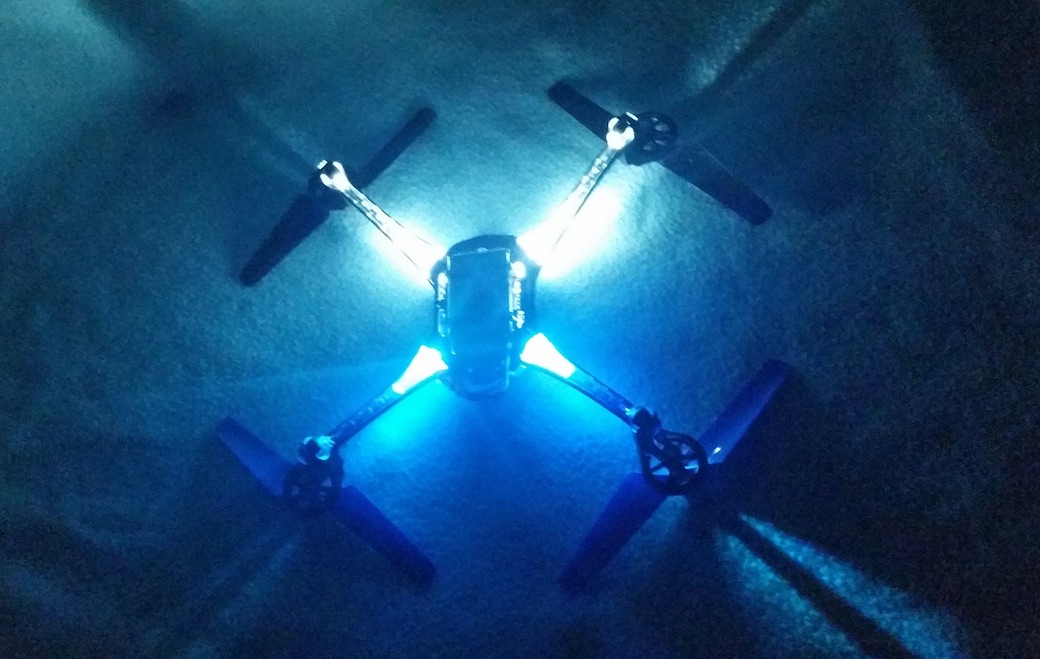 So, as hinted at above, while testing the Alias drone I actually skipped its Easy Mode and went straight for Fast Mode. This was because I wanted to try those amazing acrobatic tricks right away. Of course, in Expert Mode you have full control over everything, but this is a somewhat scary mode to fly in unless you’re a real piloting expert. The Alias can take off pretty quickly on you, so if your flying skills aren’t at least somewhat advanced, you’re more than likely going to have to periodically ditch your drone. If you’re flying over friendly terrain, this may not be so bad. For example, if you ditch on grass, you’re not likely to do all that much damage (depending on your speed and angle of impact). However, if the area you’re flying over is rocky and treacherous, I would suggest avoiding Expert Mode until your pilot training is complete. Expert Mode is certainly great for more experienced pilots though. If you wish to have total freedom over where and how your Alias Drone flies, then flying in Expert Mode is a must. Just don’t get too bold too soon!
So, as hinted at above, while testing the Alias drone I actually skipped its Easy Mode and went straight for Fast Mode. This was because I wanted to try those amazing acrobatic tricks right away. Of course, in Expert Mode you have full control over everything, but this is a somewhat scary mode to fly in unless you’re a real piloting expert. The Alias can take off pretty quickly on you, so if your flying skills aren’t at least somewhat advanced, you’re more than likely going to have to periodically ditch your drone. If you’re flying over friendly terrain, this may not be so bad. For example, if you ditch on grass, you’re not likely to do all that much damage (depending on your speed and angle of impact). However, if the area you’re flying over is rocky and treacherous, I would suggest avoiding Expert Mode until your pilot training is complete. Expert Mode is certainly great for more experienced pilots though. If you wish to have total freedom over where and how your Alias Drone flies, then flying in Expert Mode is a must. Just don’t get too bold too soon!
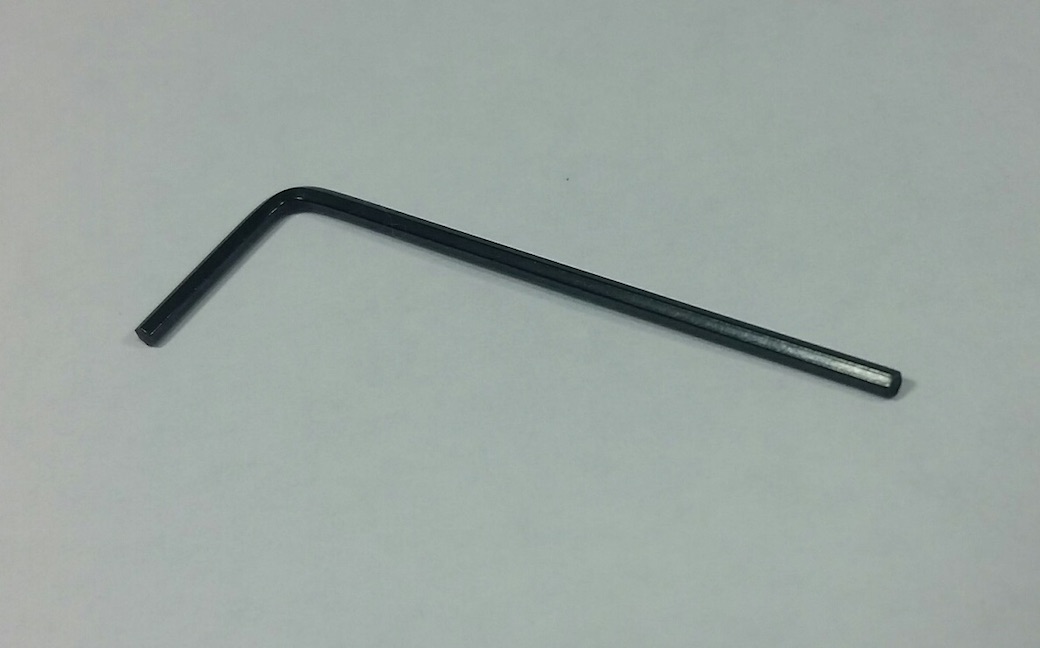 Included with the Alias Drone are a 1.5 mm Hex Wrench (shown at right) for changing out the 4 (also included) rotors (shown in the photo gallery below) as well as a Quick Start Guide & the complete Owner’s Manual. Of course, there’s also all of the other bits & bobs that I’ve mentioned throughout the article, such as the 4 AAA batteries, the single celled 3.7V LiPo, & the USB compatible charger (which features the option of 2 distinct charging rates: fast and normal). All in all it’s a fairly nice setup that I’m sure most drone enthusiasts will very much appreciate.
Included with the Alias Drone are a 1.5 mm Hex Wrench (shown at right) for changing out the 4 (also included) rotors (shown in the photo gallery below) as well as a Quick Start Guide & the complete Owner’s Manual. Of course, there’s also all of the other bits & bobs that I’ve mentioned throughout the article, such as the 4 AAA batteries, the single celled 3.7V LiPo, & the USB compatible charger (which features the option of 2 distinct charging rates: fast and normal). All in all it’s a fairly nice setup that I’m sure most drone enthusiasts will very much appreciate.
EXAMINING THE VIDEO EVIDENCE
Please take a few moments to enjoy my brief video overview of the Alias Quadcopter Drone. In it I do my best to perform some of its extremely cool stunts, and I also take a close up look at the drone itself, along with all of its included goodies:
FINAL THOUGHTS
If you’ve got the skills to handle a fast and furious drone, then you’re likely to really enjoy the Alias. Unfortunately for me, I am not quite there yet. But this doesn’t mean that I’m not recommending the Alias. As with most things, this drone certainly has its place, and, judging from what I’ve been able to ascertain, those who like it do seem to like it a lot. It’s really just a matter of skill. If you can handle the Alias in anything other than its Easy Mode, then you’re bound to get the most out of it. Moreover, if you’re a novice or inexperienced pilot, simply take your time getting used to the Alias. As you gain valuable piloting experience in Easy Mode, your confidence and capabilities will begin to grow. A little bit of patience will definitely go a long way here, and it won’t be long at all before you’ll be ready for both the Fast, and ultimately, Heaven forbid, the Expert Modes! Good luck and happy flying!
Final Note: Best Buy is having a massive toy contest that you absolutely don’t want to miss out on! Click on the embedded link to go and read all about it, and then, for goodness sake, enter!!!

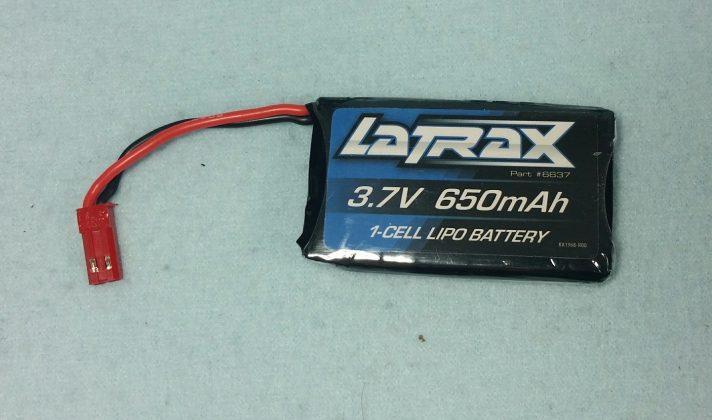
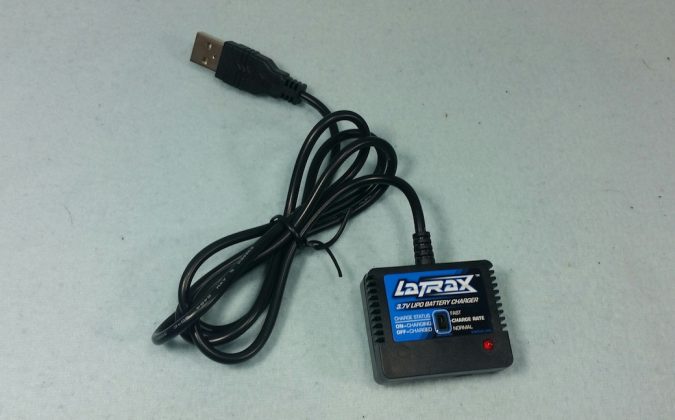



The alias is very tough!! My friend had his stuck on roof of our complex.. FOR ALMOST 2 YEARS. Wind blew it off and all he did was changed battery which was puffed and destroyed.. And motors..and it still works..true testament to how strong electronics are.
Comments are closed.